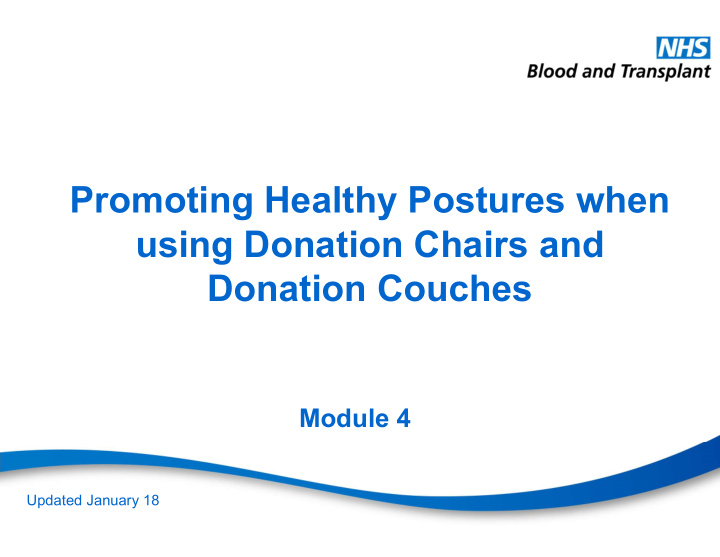



Promoting Healthy Postures when using Donation Chairs and Donation Couches Module 4 Updated January 18
If delegates are mobile team based only • Part 1 needs to be completed If delegates are donor centre based only • Part 2 needs to be completed If delegates work in both environments • Parts 1 & 2 need to be completed
Mobile Team Part 1
Learning Outcomes 1. Adjusting the Seat Position Using Lever 2. Chair Positions and Healthy Postures 3. Effective Communication 4. Emergency Evacuation
Adjusting the lever on the chair Up is open Part way Down is closed 5
Relevant General Principles • Know your limitations. Ask for help. • Clear communication with the donor • Maintain a neutral spine • Stable, flexible base . Feet shoulder width apart • Soft knees and hips • Face direction of travel (no twisting) • Effort in direction of force • Stay close to load
Communication: Key Words and Phrases On recline, encourage the donor to: • Sit right back in the chair and put their head against the head rest • Not to make any sudden movements during the process • Keep hands on lap • Look up to the ceiling • Raise their legs if they are able to Assistance from colleagues: • Assessing when this is required - if the chair remains stationary once the lever has been released • Agreeing with each other how you will communicate this
Communicate 1 Preparing Your Donor Donor or Donor Carer -adjust the head rest to suit level of comfort “I’m about to recline the chair. Please look up, and if you’re able, raise your legs” Adjust the “Ensure you’re sat back foot rest in the chair and place your hands on your lap”
2i Ensure you are square onto the lever as you squat to release it Reclining Your Donor Where there’s room, straighten the arm rest Re-adjust your feet to a lunge position as close to the chair as possible Strong hand hold Don’t over reach. Effort in the direction of force
2ii TOP TIP: If the chair does not start Reclining Your Donor to recline when the lever is released then Suggestion: When discreetly ask working in pairs to for help from a recline the donation colleague. chair, this is a good manoeuvre for the assisting colleague. Don’t forget: Communicate – “ready, steady, move”
3 Advise the donor that you are about to start sitting them up and ask that they keep lying back in the chair. Sitting Up Your Donor HOWEVER , if the chair does not start to move on it’s own once the lever is released then request the donor tips their chin toward their chest If the chair comes up rapidly, DON’T TRY AND STOP IT Adjust your base just keep the donor – from square in the position they onto lever to are in for longer either side of the and monitor them base frame front leg.
X Why can’t I do it this way? X X X
Reclining the Donation Chair Sitting the Donor Back Up and Communication Time to practice these techniques together, acting as donor / member of staff and between colleagues where assistance is required to ensure the health and wellbeing of all.
Emergency Evacuation 14 14
Learning Outcomes 1. Adjusting the Seat Position Using Lever 2. Chair Positions and Healthy Postures 3. Effective Communication 4. Emergency Evacuation?
• If not continuing to the Donation Couches presentation – Part 2 Any Questions ?
Donor Centre Part 2
Course Aims Healthy Postures when using Component Donation Couches Practical application to confirm your competency in performing the following techniques: •Relevant General Principles •Reclining Donors and Returning them Back to the Upright Position Ensure Awareness of the impact of a poor posture on your health and wellbeing Clear Communication . Working effectively with the Donor and your Colleagues - Key Words and Phrases to Use
Relevant General Principles • Know your limitations. Ask for help. • Clear communication with the donor • Maintain a neutral spine • Stable, flexible base . Feet shoulder width apart • Soft knees and hips • Face direction of travel (no twisting) • Effort in direction of force • Stay close to load
Communication: Key Words and Phrases On recline, encourage the donor to: • Sit right back in the chair and put their head against the head rest • Not to make any sudden movements during the process • Keep hands on lap • Look up to the ceiling • Raise their legs if they are able to Assistance from colleagues: • Assessing when this is required - if the chair remains stationary once the lever has been released • Agreeing with each other how you will communicate this
Reclining the component donation couch
Sitting the Donor back up
Reclining the Component Donation Couch Sitting the Donor back up and Communication Time to practice these techniques together, acting as donor / member of staff and between colleagues where assistance is required to ensure the health and wellbeing of all.
Learning Outcomes Making Healthy Postures an everyday “habit” when using Component Donation Couches Practical application to confirm your competency in performing the following techniques: •Relevant General Principles •Reclining Donors and Returning them Back to the Upright Position Ensure Awareness of the impact of a poor posture on your health and wellbeing Clear Communication . Working effectively with the Donor and your Colleagues - Key Words and Phrases to Use
Any Questions ?
Recommend
More recommend